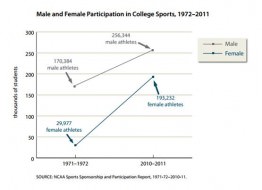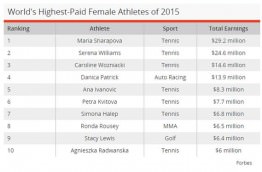My mother graduated high school in 1971 – One year before the passage of Title IX. She didn’t play a sport in school, and many colleges at the time still did not accept women. Fast-forward 23 years to 1994. I graduated high school with seven varsity letters in three different sports. I went on to participate in a club sport at my university, where only 25 years earlier, women were first admitted.
The progress brought about by Title IX at the high school and college level ushered in a new era (and attitude) toward female athletes. In doing so, it allowed young women, like me, to see sports as something they could achieve and excel at in high school and college.
In the years since Title IX was passed, the number of girls and women participating in athletics has continued to grow exponentially. According to the National Coalition for Women and Girls in Education, female athletes accounted for 41 percent of all high school athletes in the 2009-2010 school year. That same year, women received 48 percent of the total athletic scholarship dollars to Division 1 schools.
But for all of the benefits of Title IX, beyond the collegiate ranks, it didn’t apply. Professional sports as a whole have traditionally been a male-dominated business.
Except, in many ways, for tennis. I had the chance to speak to four women who have been leaders in the sport prior to, during and after the passage of Title IX. Their experiences prove that women in tennis have always been, and will continue to be, game changers.
More Money, More Problems?
USTA Florida President Nancy Horowitz explains, “In 1973, Billie Jean King’s historic match against Bobby Riggs where he called her ‘women’s libber leader’ was the beginning of the push for ladies. Prize money was out there but the men were way ahead of the women.”
And when it came to equality, USPTA President Trish Faulkner, who played on the tour from 1962 to 1974, and won nine international titles, says the disparity in prize money was really the catalyst for gender bias on the tour.
“I grew up in Australia where everyone played sports and many of our events had combined divisions with boys and girls. Because we had an equal number of well known sports figures who were male and female and there was no money involved, there was no gender bias,” she explains.
“Once I started playing the International Tour, all of the tournaments featured both men and women at the same venues. As far as I know the top women drew as much interest as the men, except perhaps in Italy. Once legitimate prize money was offered with larger purses going to the men this seemed to be the first time there was ever any visible schism between the sexes. When it came to who the directors wanted to promote and how much they were willing to offer, there was at least a 40 percent difference. Frequently even the top women’s matches were played on secondary courts compared to the men’s matches,” Faulkner says.
Former World No. 3, and Grand Slam Champion, Mary Pierce, who played on the tour in the early 90s and 2000s, agrees that the disparity in how matches were scheduled and highlighted was evident during her time on the tour.
“My first year on the tour was in 1989 and I played in the 90s and early 2000s. In general, it’s a man’s world. You always felt like the men had a bit more attention or advantage,” she says. “The thing that was exciting was that we had such an exciting sport and so many exciting players in women’s tennis when I was coming up. To me, it was fair that it should always be equal. In terms of which match should be the showcase match or how much women were getting paid, it should always be equal.”
Faulkner credits sponsors, like Philip Morris, for really elevating the women’s tour by offering greater prize money and exposure.
“Virginia Slims certainly brought women’s tennis into the mainstream providing great marketing and promotional opportunities to the tournament directors and although the greater percentage of the initial crowds were 65 percent female, women’s tennis and the names of the top players became more famous and more marketable,” she says.
“Both Avon and Slims did a very good job of taking women’s tennis to the masses. As the top players became more marketable there were more tournaments on TV. At this stage the women’s tour offered prize money all the way down through qualifying where as the men had more prize money overall but a great percentage of it went to the top 16 in every tournament and there was no prize money in qualifying,” Faulkner explains.
In 2007, USTA and the ITF made history when they agreed to give equal prize money at all four Grand Slam events. It was a watershed moment in sports equality that is largely unmatched today. Only two other sports (World Major Marathon Series and World Surf League) currently offer women the same championship prize money as men.
Today, 7 of the 10 highest paid female professional athletes are tennis professionals. In a recent article, Fortune said it’s time for soccer to follow the tennis lead in equal pay.
Both Faulkner and Pierce agree that players should be paid on performance, nothing less.
“Forget about the endorsements that come with high rankings. Tennis players who don’t perform don’t make a lot of money. This makes our sport so much more authentic and upstanding as you get paid on your play, which is very different from the guarantees, baseball, football, basketball and hockey players are given up front,” says Faulkner.
Pierce adds, “We don’t get paid by the hour. Men can play a five-hour match or a two-hour match and get paid the same, and women can play a three-hour match or a 45-minute match. It’s about the entertainment value.”
Media: Friend or Foe?
There is no question that the media, including the advent of social media, have played an important role in the growth of women’s professional sports during the past decade. This year’s ESPY’s focused heavily on the accomplishments of female athletes, giving them top honors, even above male peers.
As Pierce explains, the media has provided an important platform for women athletes. “I think the media has done a great job. We need the media, and the media needs us. They came along for the ride and stepped up and helped us (women tennis players) voice our opinions and be heard and get to that point,” she says.
But that attention is somewhat of a double-edged sword. Top females athletes still encounter a certain scrutiny that their male counterparts do not, particularly when it comes to physical appearance.
Alexandra Cercone, a 23-year-old graduate of the University of Florida, who is just starting on the WTA tour, says the sexualization of female athletes in the media is an issue, and is felt more acutely by tennis players when compared to other female athletes.
“The women on that [US National Soccer] team are ambassadors for female empowerment. Soccer doesn’t rely as heavily on the sexualization of women like tennis does with the short skirts and tight clothes,” she says.
Cercone’s point about the expectations for female tennis players to look a certain way was emphasized recently in a piece by the New York Times, which led to more body-shaming on Twitter and a subsequent response by Slate Magazine. It was just the latest in an ongoing diatribe regarding Serena Williams’ (and other female athletes) muscular frame.
.@diegtristan8 “she is built like a man”. Yeah, my husband looks just like this in a dress. You’re an idiot. pic.twitter.com/BCvT10MYkI
— J.K. Rowling (@jk_rowling) July 11, 2015
While most of the top female athletes ignore the rhetoric, Undefeated UFC Bantam Weight Champion Rhonda Rousey has pulled no punches when responding to those who criticize her masculine frame.
What these examples show is that, despite the progress of women athletes, we still have work to do when it comes to public perception and bias. Progress is not always linear, and both the media and the players have a role in combating the unfair scrutiny about appearance that is still a part of women’s tennis.
Cercone says, “I think that overall, athletes in the media need to be geared more towards things relevant to sport.”
Both Horowitz and Faulkner say female athletes also must be better trained to handle the media and focus more on the depth of the sport than the superficial points that are often covered.
“Once you become a public figure, you need to grow and develop the skills needed to be in the limelight. Being a role model for kids is extremely important. The more you win, the more coverage you get. We have seen Serena as she wins more titles grow into the public view through media coverage and sports news,” Horowitz says.
“I think that the general public relate well and respect all top female athletes now. Women tennis players who are in the spotlight should be better trained to handle the press and they should give more in-depth interviews,” Faulkner adds.
Women in Coaching
While tennis is clearly leading the way for women athletes in terms of pay and play opportunities, there is still more work to do to give women more opportunities in the professional ranks, especially coaching.
“There are a lot of women out there who have a lot to give to tennis. There could be a lot more great women coaches out there. It’s like any job in the world today… That position should be open to the most qualified male or female,” explains Pierce.
Pierce says she was impressed by Andy Murray’s bold move to take on Amelie Mauresmo as his coach, following his departure from tennis legend Ivan Lendl. It helped open the door for other women and for players to think differently about what a female coach can bring to the table.
“She did a great job, Andy was successful. Goes to show whoever is best suited should get the job. We need to have a program for women who are playing tennis and going through college and pros to help get them into coaching. Show that there is a place for them,” Pierce says.
Tennis is not the only sport taking notice of the important role that women can play off the court. Other sports have followed suit, with the San Antonio Spurs, Sacramento Kings and Arizona Cardinals bringing on women coaches this season. The trend led CNN to recently ask, “Is the future of coaching female?”
As President of USPTA, Faulkner has made it a priority to provide a fair and equal pathway for women members, and it appears to be taking hold.
“The USPTA is pushing diversity, as only 18 percent of our membership is female. Simply by nature of the requirements of the work involved, the USPTA expects to have a majority of male members. However, 18 to 20 percent is still too low. It should be more like 35 percent. We are happy to see that in our U30 initiative 50 percent of the pros being certified are female,” she says.
Faulkner says many of the top country clubs and facilities in Florida have female Tennis Directors.
“I think in the workplace and the professional tour, if you perform well and do your best, then you should be paid as well as your peers, be they male or female,” She adds.
Horowitz, a long-time volunteer, is working through USTA Florida to reach out to other groups who represent women to bring them into the organization, especially at higher levels.
“We need to let them know what a wonderful opportunity is available to be a leader or manager and there is a bright future ahead of them on many levels. Male or female, the final decision needs to be based on who is right for this job,” she says.
Although they have vastly different roles and experiences, all of these outstanding women in tennis believe without a doubt that tennis continues to be the premiere women’s sport in the world. And keeping it that way really starts at the local level, with all of us.
“It starts at the grassroots level. In schools, educating the kids, educating parents is really important. How much time is being spent with one child versus another. How many events or tournaments you have. Now there are boys and girls in both age divisions. Anyone can play it at any age,” Pierce says.
Anyone can play at any age. Now, that’s equality.








